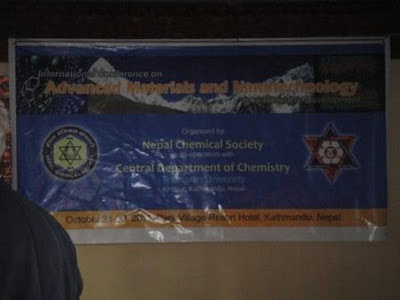There were fewer than 1,000 people in the tiny Nepalese village of Tanahun district when Jefferson Lab SRF Scientist Pashupati Dhakal grew up there. He was the son of the village's school principal. And at that time, the local school only went through middle school. Had he stayed there, it would have been a two-hour trek by foot to the nearest high school. Instead, he moved in with his grandfather in Pokhara, a popular tourist destination in Nepal.
"This," he said with a sweep of his hand toward a stunning computer screen shot of the Himalayas, "is the view I woke up to every morning."
Impressive, indeed. Almost as impressive as Dhakal's abilities in math, which came to him early and were nurtured throughout his education. His first physics teacher at Tribhuvan University, where he did his undergraduate work, was, in Dhakal's words, "brilliant" and lured him into the field.
"Studying with him made up my mind," he recalled. "That's when I said 'I want to be a physicist.'"
He stayed on at Tribhuvan University for his master's degree, which he received in 2002, after presenting his dissertation titled, "Thickness Dependence of Chemical Potential in Degenerate Semiconductor." When he graduated, he had the highest score in the department and received a gold medal from Gyanendra Bir Bikran Shah Dev, the king of Nepal.
Dhakal was offered a two-year teaching position for undergraduates and some graduate students while a professor went on sabbatical at the same department where he had completed his master's degree. "I learned even more by actually teaching physics," he noted.
As that job was ending, he applied to 10 schools in the United States and had five offers. He chose Boston College, not only for its physics department, but because he wanted a cosmopolitan atmosphere, and he had a friend from Tribhuvan University that had preceded him there. "I'd seen enough mountains," Dhakal said with a laugh. "I was ready for a city."
The flight from Nepal to the U.S. took 36 hours and brought him, literally, to the other side of the world. From what he knew about the U.S., he thought he'd be eating sandwiches all the time. Discovering Boston's ethnic groceries and restaurants was a relief. In fact, his friend's wife cooked him a traditional Nepalese meal on his first day.
In graduate school, he was interested in condensed matter physics studying the very exotic properties of materials in ultra-cold temperatures and very high magnetic fields. Working with his Ph.D. supervisor, Michael Naughton, he became skilled in several experimental techniques as well as the theoretical knowledge on condensed matter physics. Dhakal finished his Ph.D. in August 2010 after presenting his dissertation, "Angular Magnetoresistance Oscillations in the Molecular Organic Conductor (DMET)2I3: Experiment and Calculation."
In between there had been important business at home to tend to. In 2006, he returned to Nepal to meet, Sangita, the woman who would become his wife. In his culture, he explained, it is not a singular man and woman who are marrying, but the extended families. Sangita's brother-in-law and Dhakal's uncle were friends and thought they would make a perfect couple. In keeping with his home country's tradition, the couple met once and talked about their educations and plans for the future.
"In western culture, you think love must come first, but we marry and let the love grow," he said fondly. When Dhakal joined Jefferson Lab'sSRF Institute in the fall of 2010, Sangita stayed behind in Boston to finish her own education and received her nursing degree in December, after which she joined him here. Their daughter, Swarupa, is a few months old now.
"She's one of the nicest babies," he crooned with a new father's smile, "and she's a good sleeper."
Dhakal is teamed with scientists Gianluigi Ciovati and Ganapati Myneni – researching the superconducting properties of niobium, which he described as being "the heart and soul" of SRF, or superconducting radiofrequency technology. He is studying how it changes with heat and surface treatment procedures which are used during the fabrication of SRF cavities. The second part of his work involves researching ways to improve the quality factor of SRF cavities (Q0), which is limited by the so called residual loss. This means finding ways to reduce, eliminate or manage impurities and contaminates while fabricating and processing SRF cavities.
"A new kind of clean, ultra-high vacuum induction furnace has been recently acquired to avoid contamination on niobium cavities during the heating process," he explained of a portion of the process necessary to prepare the cavities. "We have preliminary results, which look very good. They are showing signs of improvement."
When evenings and weekends roll around, Dhakal enjoys following sports on TV. "I watch anything," he said with a laugh. Learning the American games was tricky; it took him a while to figure out that U.S. football players touch the ball with their hands instead of just their feet.
His parents have been visiting, to help out with the new baby and Dhakal had the opportunity to take them to New York City. "I took them to the 86th floor of the Empire State Building and said to them, 'This is the real America.'"
By Judi Tull
Feature writer




























